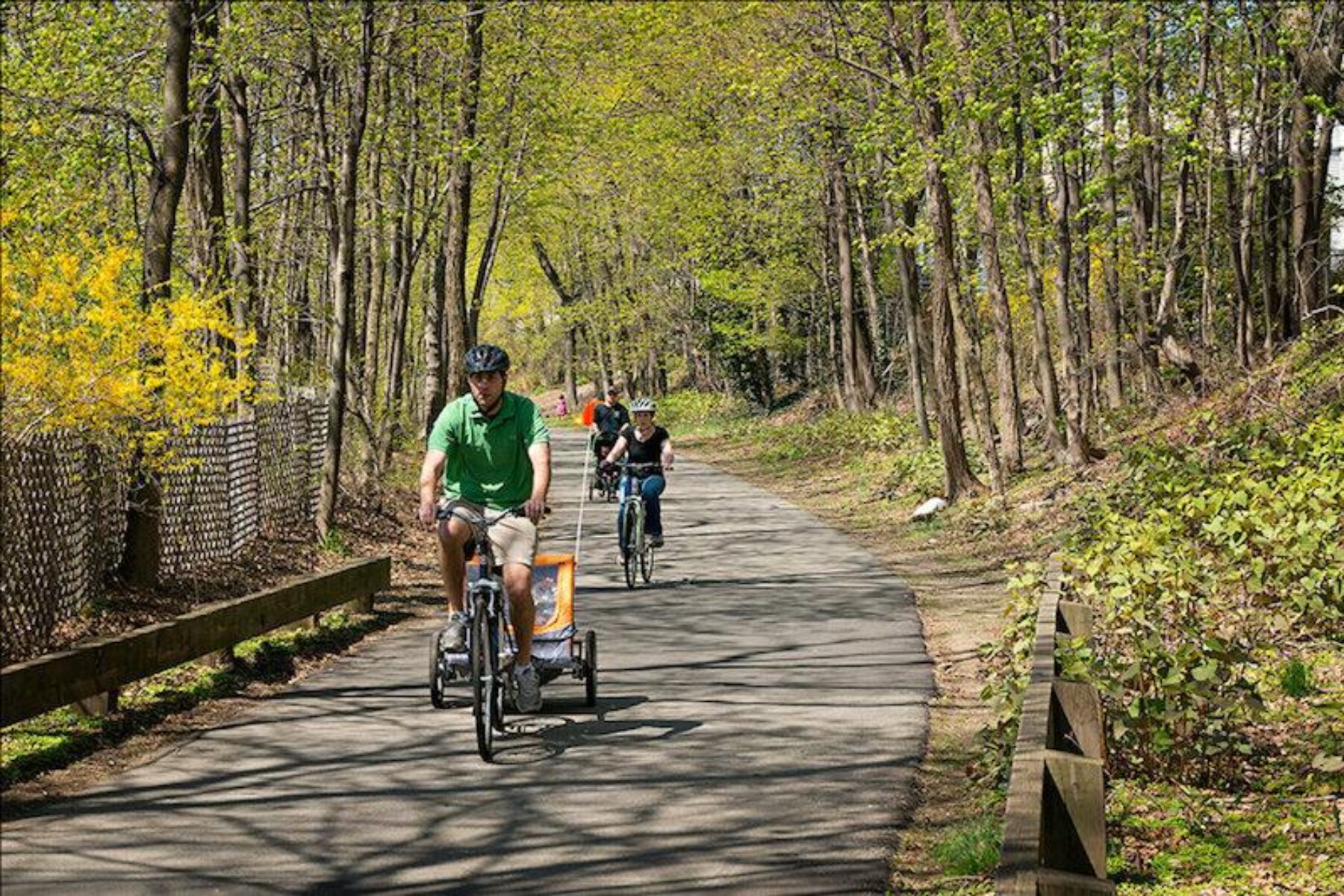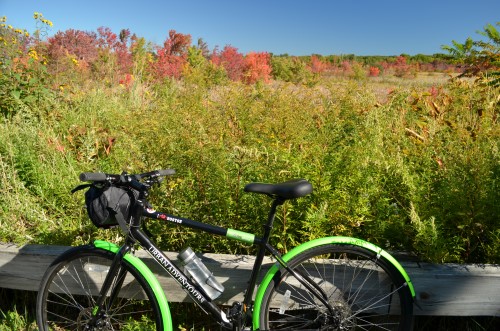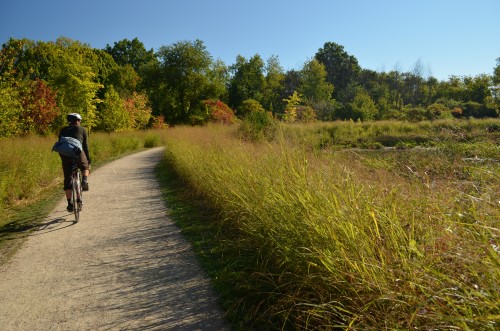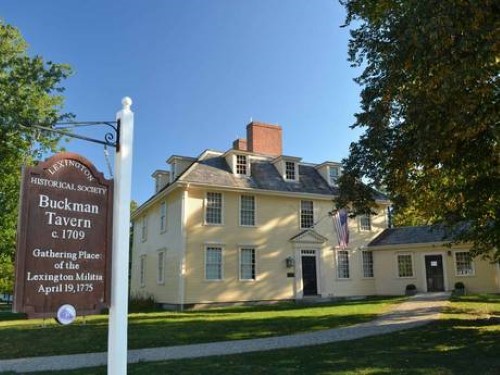The Minuteman Bikeway (A Revolution on Two Wheels)

Special thanks to The Independent for allowing us to republish this great travel article by Paul Bloomfield, first published on Monday, April 20, 2015, and originally titled “Cycling in America: A Revolution on Two Wheels.” Also, a shout out to RTC member Dr. Jeff Roth who assisted with the article.
A patriot’s journey from Boston to Lexington 240 years ago marked the start of a rebellion. Paul Bloomfield followed his route.
Names can be deceptive. I was perched on the saddle of my [rental] bike on the first stretch of the Minuteman Bikeway in northern Cambridge. Urban Boston lay behind me; a smooth sweep of asphalt curved away into rural Massachusetts, past clapboard houses, mills, ponds and meadows. And alongside me was a monolithic gatepost marking the start of the trail, bearing the traditional name of this spot: Alewife.

Given Boston’s rich colonial heritage, I’d high hopes of a captivating historic back story. The tale would, naturally, star a buxom tavern-keeper’s partner, sloshing foam-topped flagons while clouting a couple of oppressive redcoats. But no. Etched into the slabs were clues to the real source of the name: fish.
“The name was originally pronounced ‘all-wuff’, I believe,” confirmed my guide, Dr. Jeff Roth, sheepishly. “It’s a little herring common in nearby brooks.”
But if the starting line’s etymology was drab, the journey didn’t follow suit. The Minuteman Bikeway is billed as “America’s Revolutionary Rail-Trail”: an 11-mile Tarmac ribbon that follows, roughly speaking, the route taken from Boston to Lexington by Paul Revere on his night ride of 18 April 1775—240 years ago—to alert the rebel militia of the imminent arrival of British redcoats. The results were the first battles of the American Revolution on Lexington Green and, later, at Concord’s Old North Bridge—site of the so-called “shot heard around the world.”
Though nostalgically named after the best-trained colonial militia, the Minuteman Bikeway is not some glammed-up jaunt linking historic sites, but a busy commuter route. Even so, on the 250th anniversary of the founding of the Sons of Liberty—the band of feisty colonials whose anti-tax rebellion in 1765 kick-started the American independence movement—it seemed an apt activity during a short break in Boston.
The bikeway’s genesis was revolutionary in another respect. Pioneering local activists battled for 17 years to transform a disused railway into today’s cycle trail, opened in 1992. In fact, the Minuteman project was the vanguard of what’s now a pan-U.S. movement, the Rails-to-Trails Conservancy that provides advocacy and advice to communities working to convert mothballed lines.
Jeff is one such community representative, working in tandem with Rails-to-Trails to develop bikeways. By day, though, he’s a scientist at an MIT lab near Lexington, and he’d kindly volunteered to point out the trail’s highlights on his commute.

They came thick and fast before we even reached Alewife. Jeff and I pedalled from my downtown Boston hotel—the Revere, appropriately enough—at 7:30 a.m. to sidestep the heaviest rush-hour logjams. We escaped the traffic through the Public Garden, sharing the paths with walkers and in-line skaters, on to the busy cycle track along the Charles River Esplanade.
Harvard hoved into view on the opposite bank, the shouts of coxes echoing across the Charles as college rowing crews glided past. Over Anderson Bridge and through Harvard Square we rode, the red-brick, round-bay-fronted townhouses of Boston yielding to the clapboard-clad New England abodes of Cambridge.
By 9 a.m. we reached Alewife “T” Station, where those twin fish-etched stones announced the Minuteman. The first stretch is flanked by the backyards of suburban houses, but before long it opened up to reveal the tree-fringed waters of Spy Pond. In the mid-19th century, this was the epicentre of an ice-harvesting industry, slippery blocks cut and transported by rail to Boston’s harbour and on to the Caribbean. More intriguing to my mind was the story, recounted on an interpretation board, of old Mother Batherwick who, while gathering dandelions here on 19 April 1775, happened upon six British soldiers retreating from the battles inland—and promptly took them prisoner.
More historic and natural gems followed. At Arlington, we rode under the steely (OK, bronzy) gaze of Uncle Sam—the Uncle Sam: one Samuel Wilson, a merchant born in Arlington, who won renown supplying the U.S. army during the war of 1812. Then came Schwamb Mill, the country’s oldest continuously operating mill site, where wood has been shaped since around 1650; and Arlington’s Great Meadows, an undulating swathe of swaying grasses, where crickets chirped their songs of summer under the trees.

Dashing through Lexington, we powered on to the Minuteman’s end at Bedford where, had time permitted, I could have followed the dirt-track Reformatory Branch Trail to Concord’s revolutionary sites.
For me, though, it was the end of the line. After a brief pause to photograph gleaming railcar No. 6211, a restored relic of the Boston and Maine Railroad, I bid Jeff farewell and zipped back to Lexington, my base for the night.
For the spot that lays claim to being the birthplace of the American Revolution, Lexington is a pleasantly understated burg. There are museums, of course—Buckman Tavern, mustering point of the militia, and the 1698 Hancock-Clarke Parsonage, where Revere warned Samuel Adams of the approaching regulars. At Battle Green, site of the first skirmish, militia leader Captain John Parker stands tall on his rocky plinth, clasping his musket, ready to defend his home town. More poignant still is the Old Burial Ground, where rustic gravestones etched with rudimentary winged skulls commemorate the travails of Lexington’s earliest settlers. Parker, who died of consumption just months after he led the rebels in battle, lies here.
You don’t have to cycle to Lexington, of course. Most visitors don’t. But in transforming a disused railway line into a bikeway, the Minuteman has created something poetic from the prosaic—and a truly winsome way to explore the history of Massachusetts’ insurrectionary forebears. Vive les revolutions!
Cycling there
His bike was provided by Urban Adventours (617.670.0637; urbanadventours.com); [rental] of a good-quality hybrid bike costs $35 for 24 hours. Lexington’s Ride Studio Café (339.970.0187; ridestudiocafe.com) provides bikes, parts, advice and great coffee.
Staying there
‣ The Inn at Hastings Park (781.301.6660; innathastingspark.com) offers doubles from $279, including breakfast.
‣ Revere Hotel (617.482.1800; reverehotel.com) has doubles from $224 a night, room only.
More information
‣ Minuteman Bikeway: minutemanbikeway.org
‣ discovernewengland.org
‣ The Independent travel offers: Discover a world of inspiring destinations.

Donate
Everyone deserves access to safe ways to walk, bike, and be active outdoors.



